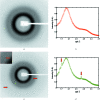Facilitating protein crystal cryoprotection in thick-walled plastic capillaries by high-pressure cryocooling
- PMID: 19529790
- PMCID: PMC2684497
- DOI: 10.1107/S0021889809011315
Facilitating protein crystal cryoprotection in thick-walled plastic capillaries by high-pressure cryocooling
Abstract
Many steps in the X-ray crystallographic solution of protein structures have been automated. However, the harvesting and cryocooling of crystals still rely primarily on manual handling, frequently with consequent mechanical damage. An attractive alternative is to grow crystals directly inside robust plastic capillaries that may be cryocooled and mounted on the beamline goniometer. In this case, it is still desirable to devise a way to cryoprotect the crystals, which is difficult owing to the poor thermal conductivity of thick plastic capillary walls and the large thermal mass of the capillary and internal mother liquor. A method is described to circumvent these difficulties. It is shown that high-pressure cryocooling substantially reduced the minimal concentrations of cryoprotectants required to cryocool water inside capillaries without formation of ice crystals. The minimal concentrations of PEG 200, PEG 400 and glycerol necessary for complete vitrification under pressure cryocooling were determined.
Figures




References
-
- Berry, I. M., Dym, O., Esnouf, R. M., Harlos, K., Meged, R., Perrakis, A., Sussman, J. L., Walter, T. S., Wilson, J. & Messerschmidt, A. (2006). Acta Cryst. D62, 1137–1149. - PubMed
-
- Blackman, M. & Lisgarten, N. D. (1957). Proc. R. Soc. London Ser. A, 239, 93–107.
-
- Chandonia, J. & Brenner, S. E. (2006). Science, 311, 347–351. - PubMed
Grants and funding
LinkOut - more resources
Full Text Sources
